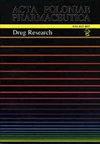Propafenone-induced liver injury in an elderly patient with paroxysmal atrial fibrillation--a new case report and literature review
IF 0.4
4区 医学
Q4 PHARMACOLOGY & PHARMACY
引用次数: 1
Abstract
Antiarrhythmic drugs are used more and more often, which is related to the aging of the population and the growing number of arrhythmias, especially atrial fibrillation (AF). One of the drugs used in AF is propafenone, considered a relatively safe drug in people without heart disease. Nevertheless, it can cause severe damage to the liver if one ignores the subtle symptoms that indicate an incipient problem. We present the case of an 82-year-old woman diagnosed with paroxysmal AF who developed acute liver injury during treatment with propafenone. On the fifth day of her hospitalization, we observed nausea and vomiting after introducing regular treatment with propafenone. Similar symptoms occurred before hospitalization when propafenone was taken ad hoc in the event of an AF attack. They were treated as dyspeptics in a patient who underwent cholecystectomy. Laboratory tests showed high serum alanine transaminase, gamma-glutamyltranspeptidase, C-reactive protein, total bilirubin, and a slight increase in aspartate transaminase. Infection with hepatic viruses, alcohol abuse, other drugs toxicity, and intrahepatic cholangitis due to cholelithiasis were excluded as a cause of liver damage. With the discontinuation of propafenone, the patient's clinical condition and laboratory test results improved. Similar cases published in the literature are discussed in the paper. It also draws attention to the need to report adverse drug reactions to the appropriate authorities and discusses the reasons for under-reporting in Poland.普罗帕酮致老年阵发性心房颤动肝损伤1例新报告并文献复习
抗心律失常药物的使用越来越频繁,这与人口老龄化和心律失常,尤其是心房颤动(AF)的数量不断增加有关。用于房颤的药物之一是普罗帕酮,它被认为是一种对没有心脏病的人相对安全的药物。然而,如果忽视了表明早期问题的细微症状,它可能会对肝脏造成严重损害。我们报告了一例82岁的妇女,她被诊断为阵发性房颤,在使用普罗帕酮治疗期间出现急性肝损伤。在她住院的第五天,我们在采用普罗帕酮常规治疗后观察到恶心和呕吐。在AF发作时临时服用普罗帕酮,住院前也出现了类似的症状。在一名接受胆囊切除术的患者中,他们被视为消化不良。实验室检测显示血清丙氨酸转氨酶、γ-谷氨酰转肽酶、C反应蛋白、总胆红素升高,天冬氨酸转氨酶略有升高。肝病毒感染、酗酒、其他药物毒性和胆结石引起的肝内胆管炎被排除为肝损伤的原因。停药普罗帕酮后,患者的临床状况和实验室检查结果有所改善。本文对文献中发表的类似案例进行了讨论。它还提请注意向有关当局报告药物不良反应的必要性,并讨论了波兰报告不足的原因。
本文章由计算机程序翻译,如有差异,请以英文原文为准。
求助全文
约1分钟内获得全文
求助全文
来源期刊
CiteScore
0.80
自引率
0.00%
发文量
74
审稿时长
6-12 weeks
期刊介绍:
The international journal of the Polish Pharmaceutical Society is published in 6 issues a year. The journal offers Open Access publication of original research papers, short communications and reviews written in English, in all areas of pharmaceutical sciences. The following areas of pharmaceutical sciences are covered: Analysis, Biopharmacy, Drug Biochemistry, Drug Synthesis, Natural Drugs, Pharmaceutical Technology, Pharmacology and General.
A bimonthly appearing in English since 1994, which continues “Acta Poloniae Pharmaceutica”, whose first issue appeared in December 1937. The war halted the activity of the journal’s creators. Issuance of “Acta Poloniae Pharmaceutica” was resumed in 1947. From 1947 the journal appeared irregularly, initially as a quarterly, then a bimonthly. In the years 1963 – 1973 alongside the Polish version appeared the English edition of the journal. Starting from 1974 only works in English are published in the journal. Since 1995 the journal has been appearing very regularly in two-month intervals (six books a year). The journal publishes original works from all fields of pharmacy, summaries of postdoctoral dissertations and laboratory notes.

 求助内容:
求助内容: 应助结果提醒方式:
应助结果提醒方式:


